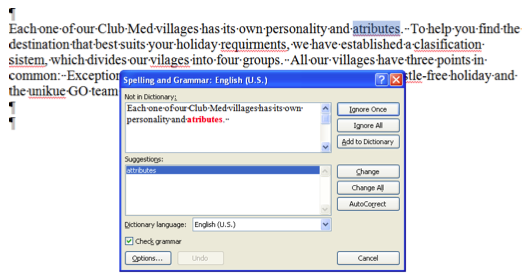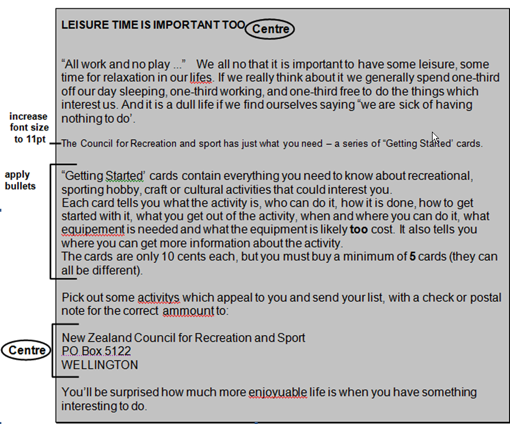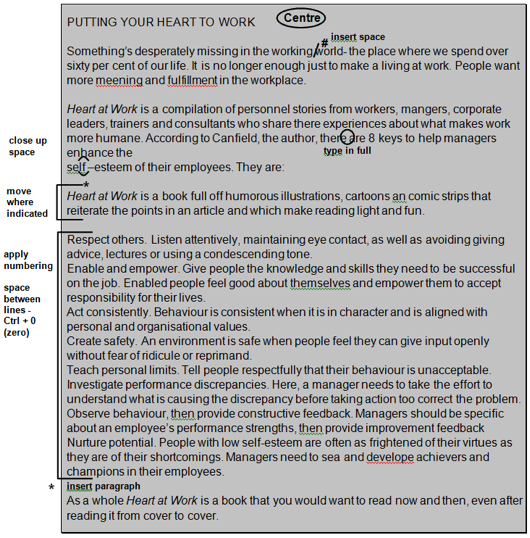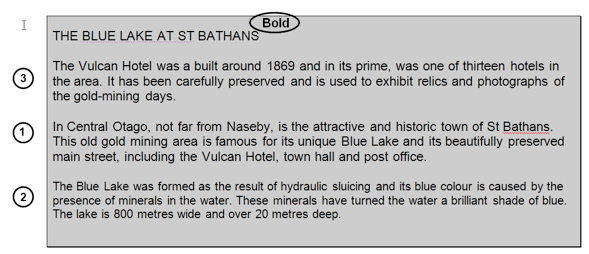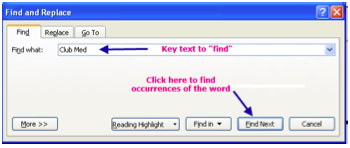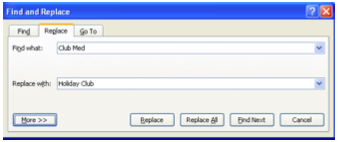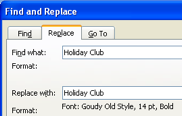A reoccurring question around Open XML is how to search and replace text in a word-processing document. There have been several attempts at presenting example code to do this, however, until now I have not seen any examples that correctly implement this. This post presents some example code that implements a correct algorithm to search and replace text.
The first challenge is handle the case when the text you are searching for spans runs with different formatting. A simple example will demonstrate the problem. You want to replace ‘Hello World’ with ‘Hi World’. If, in the document, the word ‘World’ is bolded, then the markup will look something like this:
<w:p> <w:r> <w:t xml:space="preserve">Hello </w:t> </w:r> <w:r> <w:rPr> <w:b /> </w:rPr> <w:t>World</w:t> </w:r> </w:p>
Even though the search text spans runs, the algorithm should find the text and replace it. The next challenge is to define exactly the semantics of searching and replacing text if the text that you are searching for spans runs with different formatting. In short, the replaced text takes on the run formatting of the run that contains the first character of the search string. An example makes this clear. In the following sentence, the first four characters of the word ‘include’ are bolded:
On the Insert tab, the galleries include items.
If you replace ‘include’ with ‘do not include’, then the sentence should be formatted like this:
On the Insert tab, the galleries do not include items.
The replaced text takes on the formatting of the ‘i’ character of include, which was bolded.
Here is a short screen-cast that walks through the algorithm and the code.
Search and Replace Algorithm
It certainly would be possible to carefully define an algorithm to search for text that spans runs, noting where the searched text intersects bookmarks, comments, and the like. However, this algorithm would be pretty complicated, and to be done properly, a test team would need to write extensive test specs, and supply a plethora of sample documents that exercise all edge cases. It is a non-trivial project.
However, there is another approach that we can take that is pretty simple, easy to test, and yields the correct results in all cases. The algorithm consists of:
- Concatenate all text in a paragraph into a single string, and search for the search string in the concatenated text. If the search text is found, then continue with the following steps.
- Iterate through all runs in the paragraph, and break all runs into runs of a single character. There are a variety of special characters, such as carriage return, hard tab, break, and the non-breaking hyphen character. Normally, these special characters will coexist in runs with text elements. When breaking runs into runs of a single character, these special characters should also be placed into their own run. At the end of this process, no run will contain more than a single character, whether it is a character of text, or one of the special characters that is represented by an XML element.
- After breaking runs of text into multiple runs of single characters, it is then pretty easy to iterate through the runs looking for a string of runs that match the characters in the search string.
- If the algorithm finds a string of runs that match the search string, then it inserts a new run into the document. This new run contains the run properties of the first run in the string of runs that match the search string. In addition, the algorithm deletes the set of single-character runs that matched the search string. This process is repeated until no strings of runs are found that match the search string.
- After the algorithm replaces the single-character runs with a new run containing the replacement text, then the algorithm coalesces adjacent runs with the same formatting into a single run.
Algorithm Walk-through
It will be helpful to walk through an example, and examine the markup at each step in the process. The following paragraph contains the text, “See this markup.” The letters ‘th’ in the word ‘this’ is bolded. We want to change the word ‘this’ to the word ‘the’.
<w:p> <w:r> <w:t xml:space="preserve">See </w:t> </w:r> <w:r> <w:rPr> <w:b /> </w:rPr> <w:t>th</w:t> </w:r> <w:r> <w:t>is markup.</w:t> </w:r> </w:p>
After splitting all runs into multiple runs of a single character each, the markup looks like this:
<w:p xmlns:w="http://schemas.openxmlformats.org/wordprocessingml/2006/main"> <w:r> <w:t>S</w:t> </w:r> <w:r> <w:t>e</w:t> </w:r> <w:r> <w:t>e</w:t> </w:r> <w:r> <w:t xml:space="preserve"> </w:t> </w:r> <w:r> <w:rPr> <w:b /> </w:rPr> <w:t>t</w:t> </w:r> <w:r> <w:rPr> <w:b /> </w:rPr> <w:t>h</w:t> </w:r> <w:r> <w:t>i</w:t> </w:r> <w:r> <w:t>s</w:t> </w:r> <w:r> <w:t xml:space="preserve"> </w:t> </w:r> <w:r> <w:t>m</w:t> </w:r> <w:r> <w:t>a</w:t> </w:r> <w:r> <w:t>r</w:t> </w:r> <w:r> <w:t>k</w:t> </w:r> <w:r> <w:t>u</w:t> </w:r> <w:r> <w:t>p</w:t> </w:r> <w:r> <w:t>.</w:t> </w:r> </w:p>
The algorithm can then iterate through the runs, finding the series of runs where the text of the runs matches ‘t’, ‘h’, ‘I’, ‘s’. The algorithm then inserts a new run containing the replace text, taking the run properties from the run that contained the ‘t’ in the search string, which indicates that the run is bolded. It also removes the single character runs that match the search string. The adjusted markup looks like this.
<w:p xmlns:w="http://schemas.openxmlformats.org/wordprocessingml/2006/main"> <w:r> <w:t>S</w:t> </w:r> <w:r> <w:t>e</w:t> </w:r> <w:r> <w:t>e</w:t> </w:r> <w:r> <w:t xml:space="preserve"> </w:t> </w:r> <w:r> <w:rPr> <w:b /> </w:rPr> <w:t>the</w:t> </w:r> <w:r> <w:t xml:space="preserve"> </w:t> </w:r> <w:r> <w:t>m</w:t> </w:r> <w:r> <w:t>a</w:t> </w:r> <w:r> <w:t>r</w:t> </w:r> <w:r> <w:t>k</w:t> </w:r> <w:r> <w:t>u</w:t> </w:r> <w:r> <w:t>p</w:t> </w:r> <w:r> <w:t>.</w:t> </w:r> </w:p>
Finally, the algorithm iterates through the runs, coalescing adjacent runs with identical formatting.
<w:p xmlns:w="http://schemas.openxmlformats.org/wordprocessingml/2006/main"> <w:r> <w:t xml:space="preserve">See </w:t> </w:r> <w:r> <w:rPr> <w:b /> </w:rPr> <w:t>the</w:t> </w:r> <w:r> <w:t xml:space="preserve"> markup.</w:t> </w:r> </w:p>
Additional Notes
There are a few additional notes worth mentioning about this algorithm.
- This algorithm only works for paragraphs that do not contain tracked revisions. While it is certainly possible to write this functionality for content that contains tracked revisions, it significantly complicates the algorithm. The code as written checks for the existence of tracked revisions (using the code presented in Using XML DOM to Detect Tracked Revisions in Open XML WordprocessingML Documents), and throws an exception if they exist.
- If revision tracking is turned on for a document, the correct functionality would be to create the revision tracking markup, which is beyond the scope of this example. If revision tracking is turned on, the example code throws an exception.
- While my favorite way to write these types of algorithms is to use LINQ to XML, to make this code more widely applicable, I used System.Xml.XmlDocument, which is an implementation of XML DOM. This makes it easier to translate this code to a variety of other platforms, such as PHP or Java.
- The code searches and replaces text in the main document part, all headers, all footers, the endnote part, and the footnote part.
Use the word processor’s search function to locate text and more
Updated on December 15, 2020
What to Know
- Basic word search: Go to the Home tab. Select Find and enter the text for the search.
- Advanced search: Go to Home > Find. Choose the search drop-down arrow. Select Options and select your criteria.
This article explains how to search for text in Microsoft Word. The information applies to Word 2019, Word 2016, Word 2013, Word 2010, Word Online, and Word for Microsoft 365.
How to Do a Basic Word Search in MS Word
Microsoft Word includes a search function that makes it easy to search for different elements in a document, including text. Use the basic tool to look for instances of a specific word, or the advanced options to perform tasks such as replace all instances of a word with another one or search for equations.
To run a basic search for a specific word or phrase in Word:
-
Go to the Home tab and select Find, or press Ctrl+F.
In older versions of Microsoft Word, select File > File Search.
-
In the Navigation pane, enter the text you want to search for. A list of matching words displays in the Navigation pane and instances of the word are highlighted in the main document.
-
Cycle through the results in the Navigation pane in one of three ways:
- Press Enter to move to the next result.
- Select a result with the mouse.
- Select the Up and Down arrows to move to the previous or next result.
-
Make any changes or edits to the document as needed.
-
Select the Down arrow to move to the next instance of the word.
Match Case, Whole Words Only, and More
Beyond searching for every instance of a word, you can get more specific about what you want to find. For example, to find whole instances of a word and not every word that contains the letter combination or to find instances of a word that aren’t capitalized.
Here’s how to do an advanced search:
-
Select Home > Find.
-
In the Navigation pane, select the Search drop-down arrow.
-
Choose Options.
-
In the Find Options dialog box, choose the description that best fits what you’re trying to find. For example, to find instances of a word with the same capitalization, select Match case.
-
Select OK.
Use Advanced Find
Many of the choices available in the Find Options dialog box are also available in Advanced Find. Advanced Find includes the option to replace the text with something new. Based on your selection, Word replaces one instance or all instances at once. You can also replace the formatting, or change the language, paragraph, and tab settings.
Find Instances of Other Elements
Other options in the Navigation pane include searching for equations, tables, graphics, footnotes, endnotes, and comments.
Thanks for letting us know!
Get the Latest Tech News Delivered Every Day
Subscribe
Frequently Asked Questions
What is a word search?
A word search is a puzzle where there are rows of letters placed in the shape of a square, and there are words written forwards, backwards, horizontal, vertical or diagonal. There will be a list of words for the player to look for and the goal of the player is to find those words hidden in the word search puzzle, and highlight them.
How do I choose the words to use in my word search?
Once you’ve picked a theme, choose words that have a variety of different lengths, difficulty levels and letters. You don’t need to worry about trying to fit the words together with each other because WordMint will do that for you!
How are word searches used in the classroom?
Word search games are an excellent tool for teachers, and an excellent resource for students. They help to encourage wider vocabulary, as well as testing cognitive abilities and pattern-finding skills.
Because the word search templates are completely custom, you can create suitable word searches for children in kindergarten, all the way up to college students.
Who is a word search suitable for?
One of the common word search faq’s is whether there is an age limit or what age kids can start doing word searches. The fantastic thing about word search exercises is, they are completely flexible for whatever age or reading level you need.
Word searches can use any word you like, big or small, so there are literally countless combinations that you can create for templates. It is easy to customise the template to the age or learning level of your students.
How do I create a word search template?
For the easiest word search templates, WordMint is the way to go!
Pre-made templates
For a quick an easy pre-made template, simply search through WordMint’s existing 500,000+ templates. With so many to choose from, you’re bound to find the right one for you!
Create your own from scratch
- Log in to your account (it’s free to join!)
- Head to ‘My Puzzles’
- Click ‘Create New Puzzle’ and select ‘Word Search’
- Select your layout, enter your title and your chosen words
- That’s it! The template builder will create your word search template for you and you can save it to your account, export as a Word document or PDF and print!
How can I print my word search template?
All of our templates can be exported into Microsoft Word to easily print, or you can save your work as a PDF to print for the entire class. Your puzzles get saved into your account for easy access and printing in the future, so you don’t need to worry about saving them at work or at home!
Can I create a word search in other languages?
Word searches are a fantastic resource for students learning a foreign language as it tests their reading comprehension skills in a fun, engaging way.
We have full support for word search templates in Spanish, French and Japanese with diacritics including over 100,000 images.
| Word processing | |
|---|---|
| Working with text | Introduction | Character formatting | Paragraph formatting | Editing features | Working with tabs | Key points | Assessment |
Contents
- 1 Editing
- 2 Spell Check a whole document
- 3 Activity
- 3.1 Spell check exercise
- 4 Activity
- 4.1 Editing exercise 1
- 5 Activity
- 5.1 Editing exercise 2
- 6 Activity
- 6.1 Moving and copying blocks of text
- 7 Activity
- 7.1 Moving paragraphs exercise
- 8 Activity
- 8.1 Find and Replace Text
- 8.1.1 Extra resources
- 8.1.2 Replace text automatically
- 8.1.3 Replace standard text with formatted text
- 8.1.4 Find and replace exercise
- 8.1 Find and Replace Text
- 9 Activity
- 9.1 Corrections
- 10 Activity
Editing
To edit a document is to change the way it appears: this can be by moving and inserting text, deleting text or creating and removing paragraphs.
The following functions are used when editing an existing document or text you have entered. The procedure column outlines the commands you will need to carry out in order to apply the editing feature.
| Editing Function | Procedure to use |
|---|---|
| Inserting | Click the I-Beam cursor at the point to insert, and type in the text to be inserted. |
| Overtyping | Double click OVR on the Status Bar at the bottom of the screen. Type text. Double click OVR to end overtyping or press Insert on the keyboard to begin overtyping, press Insert again to end overtyping. |
| New Paragraph | Press the Enter key twice after the end of the previous text. |
| Join Paragraphs | Place cursor at the end of the first paragraph and press Delete twice or place cursor at the beginning of the second paragraph and press Backspace twice. Press the Spacebar. |
| Delete to right of cursor | Press the Delete key. (Ctrl + Delete deletes a word to the right). |
| Delete to left of cursor | Press the Backspace key. (Ctrl + Backspace deletes a word to the left). |
| Delete a blank line | Place the cursor on the blank line and press Delete. |
| Insert a blank line | Place the cursor where you want the new line and press Enter. |
| Undo last action | Click the Undo button or click the Edit menu then select Undo. |
| Redo last “Undo” | Click the Redo button to redo the last “Undo” or click the Edit menu then select Redo. |
| Typing Replaces Selection | Select (highlight) text and type in new text. |
| Transpose text (swap) | Select the second part of the text to be swapped. Click the Edit menu, then click Cut. Click the cursor where you want the text to be placed. Click the Edit menu, then click Paste. |
Spell Check a whole document
The Spell checker is great for picking up errors but don’t rely on it entirely. A word may be spelt correctly but still not be correct e.g. here/hear, went/want, their/there. It is still very important to proofread (check) your document before printing.
Activity
Please note: the following tutorial will open in a new window/tab. When you have finished the tutorial, simply close the window/tab and you’ll return to this page.
Before you go on, please work through the following tutorial:
- Proofing Features
Don’t forget to watch the 3-minute video on page 2!
- Click on Customize Quick Access Toolbar and add Spelling & Grammar
- Click on
.
The Spelling and Grammar dialog box will appear and the cursor will move to the first incorrect word and highlight the word.
- The spell check feature automatically gives you some options down the right hand side of the dialog box.
This is what each option means:
- Change
- When the word is spelt incorrectly click on the correct spelling from the list of suggestions, then click on Change.
- Ignore Once
- Click on Ignore Once when you know the word is spelt correctly but is not in the dictionary and you are not likely to use it again e.g. an odd place name
- Add to Dictionary
- When you know the word is spelt correctly and you are likely to use it again e.g. your name, highlight the “incorrect” word and click on Add to Dictionary. The highlighted word will be added to your own Custom Dictionary rather than the main Word dictionary.
Spell check exercise
Activity
- Open the page called Words. Follow the instructions there.
- Create a new Word document and paste in the text you copied from the Words page. Save the document as Words.
- Use either of the two methods outlined on the previous pages for checking the Spelling and Grammar of the document.
- Change the line spacing of the paragraph to double (2.0)
- Print Preview your document to see hot i looks, then close Print Preview
- Turn the Show / Hide Feature on
- Justify the document (alignment)
- Close the document saving the changes you made
Editing exercise 1
Activity
- Open the page called Leisure. Follow the instructions there.
- Create a new Word document and paste in the text you copied from the Leisure page. Save the document as Leisure Time.
- Follow the instructions as indicated below to change the document:
- Check the spelling and grammar of the document.
- Save and close the document
Editing exercise 2
Activity
- Open the page called Heart at work. Follow the instructions there.
- Create a new Word document and paste in the text you copied from the Heart at work page. Save the document as Heart at work.
- Follow the instructions as indicated below to change the document:
- Check the spelling and grammar of the document.
- Save and close the document
Moving and copying blocks of text
You can change the order of words, sentences and paragraphs to improve the structure of your document. When moving or copying text, the text (plus any space required) must be selected.
When you copy or move text, the text retains the character formatting e.g. bold, font style. If the copied or moved text includes the paragraph mark ¶, the text retains the paragraph formatting e.g. line spacing, alignment.
- To move text
- Cut the text from one place in the document and paste it into another.
- To copy text
- Copy it from one place in the document and paste a copy of it into another.
Activity
Please note: the following tutorial will open in a new window/tab. When you have finished the tutorial, simply close the window/tab and you’ll return to this page.
This online tutorial includes a useful guide to moving and copying text:
- Text Basics
Moving paragraphs exercise
Activity
- Open the page called Blue Lake. Follow the instructions there
- Create a new Word document and paste in the text you copied from the Blue Lake page. Save the document as Blue Lake.
- Move the paragraphs as indicated below and ensure that only one space is left between each paragraph:
- Save the changes and close the document.
Find and Replace Text
The Find facility allows you to quickly find text and/or formats when editing a document. For example, say you find a mistake in a printed document, instead of scrolling through the document yourself; you can use Find and go straight to the mistake.
Find Text
- Go to Home Tab ⇒ Editing group
- Click on Find. (The keyboard shortcut key is Ctrl F)
- The Find dialog box will appear:
- Key the text to be found in the Find what field
- Click Find Next
Replace Text
The Replace facility allows you to replace existing text with other text and/or formats. For example, say you keyed in Club Med throughout a document and you wanted to replace it with Holiday Club, you tell Word to do this once and it happens throughout the document.
- Go to Home Tab ⇒ Editing group
- Click on Replace
- The Find and Replace dialog box will appear:
- Key the text to be found and the text you would like it to be replaced with
- Click on Find Next — the first occurrence will be highlighted
- Click on Replace
- Repeat until all occurrences have been replaced and this appears: Click on OK
- Click on Close in dialog box
Both Find and Replace save lots of time!
Replace text automatically
This time we will replace all occurrences automatically
- Press Ctrl + H to open dialog box.
- Next to Find what, enter the text to find : our.
- Next to Replace with, enter the new text: the
- Fill in options – whole word only, search all
- Close options — click on Less
- Click on Replace All
- When this appears, click on OK or press Enter
- Click on Close to close the dialog box
Replace standard text with formatted text
- Press Ctrl + H
- Key text to find: Holiday Club. Key text to replace with: Holiday Club
- Click on More
- Choose Format ⇒ Font
- The Font dialog box will appear: choose the Font, Font style and Size, then click on OK
- Click on Less and the dialog box will close up
- Check that the format is under the Replace with text, not the Find what text:
- Note: If formatting appears under Find what, this is a mistake:
- To fix this, click on No Formatting and redo making sure you are in Replace with:
- Note: If formatting appears under Find what, this is a mistake:
- Click on Replace all
- When replacement has finished, a dialog box will appear. Press Enter or click on OK.
- Print preview – Oh!!! the font size was too small with this font. So Press Ctrl + H again, click on Replace with text Holiday Club
- Change the Replace with font format to 18
- Replace all, check your Preview, then close the Preview.
- Save the changes to the document and close it
Find and replace exercise
Activity
- Locate and open the file Words you created earlier
- Use the Find and Replace tool to change the following words:
- Change France ⇒ Germany
- Change deep red ⇒ scarlet
- Change limpid ⇒ lifeless
- Save the document as Words V2.
Corrections
Note: When you have finished with this section, you can use your browser’s Back button to return to the page you were viewing.
The following correction signs are commonly used to indicate alterations in a document:
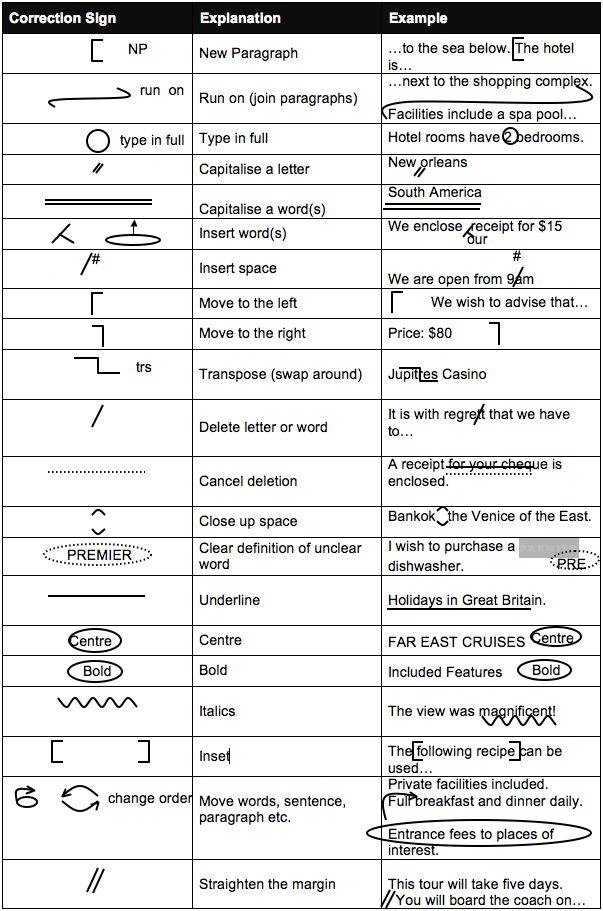
Activity
In a new document, enter the following text:
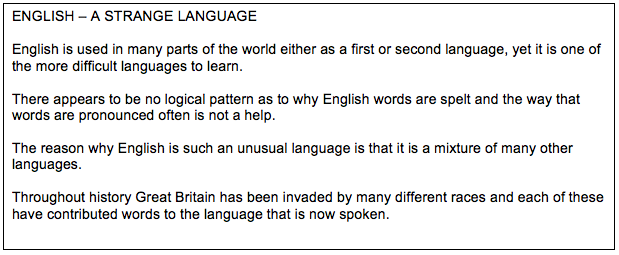
Now, referring to the correction signs above, edit the document and make the following corrections:
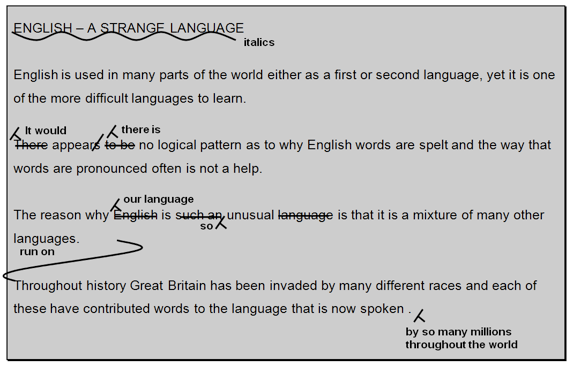
|
Word processing software helps you manipulate a text document and create or edit a text document.
-
Best 15 Word Processing Software Examples
-
1. Microsoft Word
- 2. iWork Pages
- 3. OpenOffice Writer
- 4. WordPerfect
- 5. FocusWriter
- 6. LibreOffice Writer
- 7. AbiWord
- 8. WPS Word
- 9. Polaris Docs
- 10. Writemonkey
-
11. Dropbox Paper
- 12. Scribus
- 13. SoftMaker FreeOffice TextMaker
- 14. Zoho Docs Writer
- 15. Google Docs
-
1. Microsoft Word
- Conclusion
A quality word processing software can also provide output options such as printing or exporting a text document into other formats.
Without word processing software, you would have difficulty processing paragraphs, pages, and even papers.
Not many people know that early word processing software was standalone devices, but word processors come as lightweight software that’s easy to install with technological advancements.
Another great advantage of word processing software is that it allows you to store documents electronically, display them across screens, or fully modify documents before printing them.
Even though word processing software isn’t complex to learn, it might take a bit of time to learn how to take full advantage of the software with so many functions.
Also, keep in mind that some word processing software comes from the office bundle that includes other processing software.
In this article, you’ll learn more about word processing software and see 15 of the best examples.
Whether you’re a writer, editor, or only need quality word processing software to prepare your documents pre-printing, at least one of these 15 software will be a good pick!
Even though most word processing software has similar features and offers similar benefits, the small but significant differences between these word processing software examples can make a huge difference for personal use.
1. Microsoft Word
The most known word processing software is Microsoft Word, and chances are high you’ve used it at least on one occasion to process or create text documents.
Word is the most known word processing software because the creator of Windows creates it and it often comes integrated with the Windows operating system.
However, Word is also known for the benefits it offers. Improved search and navigational experience combined with the ability to work with others simultaneously are just some of the benefits.
Along with that, Word gives you the ability to access, share, and work on your documents from almost anywhere.
With plenty of options to create, edit, and process text, Word also has additional visual effects, turning text into diagrams, and combining visual aspects into text documents.
Instant help when creating documents is another great integration that especially helps writers. Exporting and having document flexibility is helpful when producing specific documents for your studies or work, and it’s just one of many benefits of Word.
2. iWork Pages
iWork Pages is a must-have word processing software for Apple users. Even though Microsoft Word is available for macOS, iWork is a great native alternative that helps Apple users process, create, and work with word documents.
iWork Pages was previously known as AppleWorks, and it is part of the official Apple iWork suite.
Not only Pages can help you create documents, but they can also help you to collaborate with others efficiently, create animated documents from your data, and even build interactive charts from your text.
What’s great about Pages is that it comes with built-in help and sample formulas, so you don’t always have to create a document from scratch. Instead, you can use templates or benefit from function suggestions to improve the way you work.
With over 30 spreadsheet templates, you won’t have to create text documents from scratch unless you enjoy creating your work from scratch. Templates can help you spend less time formatting and creating the basics of your document and yet leave you with more time to focus on your text.
3. OpenOffice Writer
Among the paid word processing software, there are a couple of free gems such as OpenOffice.
OpenOffice is a free and open productivity suite that includes Writer, the perfect software for word processing.
Whether you’re trying to draft a quick letter or working on complex text documents (maybe even writing a book), the writer is a reliable and fully equipped word processing software to handle all needed tasks.
What’s great about Writer is that it is very easy to use, so you won’t have to spend hours learning the ins and outs of the software to take full advantage of it.
Instead, you will be able to focus on producing documents of all types and letting Writer help you along the way.
With built-in features such as AutoCorrect or AutoComplete, you can quickly write your documents without having to worry about making mistakes.
Along with these two features, OpenOffice Writer comes with a table of contents, references, multi-page display, and notes to help you annotate and review documents, as well as create well-structured text documents.
Lastly, exporting isn’t going to be a problem since Writer can help you export your text document into other formats such as HTML, PDF, or even .odt.
Also, keep in mind that OpenOffice provides templates you can download and use with Writer to make your drafts easier.
4. WordPerfect
WordPerfect is described as the Microsoft Office alternative. It is an all-in-one suite that focuses on productivity and efficiency when working with digital documents (especially text documents).
Inside the WordPerfect Office, you will have access to a neat and efficient word processor that can help you quickly draft new documents, create letters or brochures, write resumes, and even start writing a book.
What’s so special about WordPerfect is that it supports collaboration with about 60 file formats, so you can import and export documents from any third-party software.
With the help of Reveal Codes, WordPerfect provides seamless formatting after you import documents from any source.
And if you’re looking to “spice up” your text documents, you can do so easily with the help of built-in PDF forms into this powerful and versatile word processing software.
5. FocusWriter
If you spend a lot of time writing documents in your word processing software, and yet you find it hard to concentrate and focus on the words, FocusWriter is a great pick.
FocusWriter is a very simple word processing software that utilizes a versatile interface hidden away from the most important part of the software. This way, you can focus on the page and text, and whenever you need to use any integrated feature, all you have to do is swipe your cursor across the edges to open the hidden menu.
With integrated features such as timers, alarms, daily goals, fully customizable themes, and even the ability to use typewriter sound effects, this word processing software will help you stay on track and get things done.
Along with these features, FocusWriter has optional features such as live statistics, spell-checking, and even the ability to use FocusWriter in 20 different languages.
These features aim to improve the user experience and make word processing tasks fun and more productive since you can set your own goals.
This is a word processing software that adds improved features that aren’t very common among its competitors.
6. LibreOffice Writer
When you are a very organized person and need word processing software that will match this, LibreOffice Writer is worth trying.
LibreOffice Writer is a modern word processing software that ensures you can edit any document quickly with the help of integrated features.
Therefore, Writer is good enough for doing quick and simple edits. Still, it’s also more than enough to finish books, edit many content pages, add diagrams, and even feature indexes into your documents.
The user interface is very neat and even though there are many features they’re hidden away so you can focus on the most important aspect of word processing: the text.
7. AbiWord
When you require a very similar word processing software to Word, and yet you’re on a budget, AbiWord is a good choice.
AbiWord is compatible with the latest operating systems and interface-wise, it is very similar to Microsoft Word. Even though it’s not the “prettiest” word processing software, it has everything you might need to get the work done efficiently, and it won’t cost you a penny.
With compatibility to work with all standard text documents, AbiWord also allows you to share your documents with others easily or even merge your letters directly with your email.
Even though AbiWord might not have all features other word processing software include, AbiWord is built on the extensible plugin architecture, so you can always find plugins to include features you might be missing.
On top of that, I should mention that AbiWord is available in 30 different languages, and it is still getting updates so that you won’t be relying on an outdated version.
8. WPS Word
WPS offers a suite similar to Microsoft Office that includes three components: the Word, Excel, and Presentation.
Word is a word processing software that is highly compatible with almost all compatible document formats, and it is even compatible with all operations systems.
Creating documents from scratch with Word is very simple, and yet with standard formatting tools everyone is familiar with, editing documents is even easier.
On top of that, Word includes many extras that are rarely found in other word processing software, such as hundreds of document templates. Therefore, if you don’t feel like creating documents from scratch, basing your documents on pre-existing templates can save you a lot of time and work.
Combining media with text is highly possible, and viewing multiple documents simultaneously improves efficiency when working with multiple documents.
With collaboration tools, password protection for chosen documents, and automatic spell-checking tools, you can easily get your work done without worrying about accuracy.
9. Polaris Docs
Polaris Office is a combination of tools that includes Docs, a highly versatile version that’s very similar to a combination of Microsoft Word and Google Docs.
It’s a very versatile word processing software that allows you to work on your documents wherever you are.
Not only is it available as computer software, but it also has a dedicated web browser version and even the app version suitable for Android and iOS smartphones.
Collaboration is guaranteed with such versatility, and when it comes down to getting the work done, Polaris Docs supports all types of documents, including sheets, slides, and more.
Saved documents can be worked on in groups, meaning that more than one person can edit the document in real-time. And if you ever decide to collaborate on a document with someone, you can invite them with a link and keep the communication open with an integrated chat in the Polaris Docs.
Feature-wise, Polaris Docs is packed with the most standard features you would expect from a word processing software, and yet the main improvement is the way you can collaborate with others and work on the same document in real-time.
10. Writemonkey
If you search for a word processing document that will leave you on your own with your words and yet will hide all functionalities in a very minimalistic and simple interface, Writemonkey makes a great choice.
Writemonkey might look like a coding interface at first, but it is a stripped-down word processing software that helps you focus on your writing.
Of course, Writemonkey is also ideal for making quick edits and even reading.
This is probably one of the lightest and smallest word processing software that is very easy to install and even easier to get used to.
What’s also great is that you have full control over the interface to customize it to your needs. On top of that, you can set timed writing or even feature a visual progress bar to make your writing work feel like a breeze.
And if you ever end up missing something in Writemonkey, you can always introduce third-party upgrades to this word processing software via plugins.
11. Dropbox Paper
When you need a versatile, reliable, and quick word processing software that’s perhaps web-based, Dropbox Paper is worth considering.
Dropbox Paper is a lightweight web-based word processing software that allows simple editing and collaboration between teams.
With Dropbox Paper, you can create documents from scratch or import existing documents to easily track any edits or changes made by your team members. On top of that, with this light word processing software, you can keep everything organized, ensure feedback is properly given, and even improve your documents.
You can do almost everything in Dropbox Paper that you would do in other word processing software. However, Paper can also serve as a co-editing software.
Whether you’re trying to improve communication in your team, improve collaboration between team members, or you’re writing a book with your partner, Paper is the place to stay productive, organized, and efficient.
12. Scribus
If you require professional word processing software to handle your business/work documents or edit and prepare your book for publishing, Scribus is a great choice.
Even though it’s a bit different from standard word processing software, Scribus allows you to choose one of the designed layouts, set your typesetting, and even improve your written documents with professional-looking quality images.
With Scribus, you can also create animations that you can place directly inside your document, or you can turn your text documents into interactive PDF presentations.
On top of that, the creation of forms or questionnaires is very simple. With OpenType support, you can now edit your existing documents with advanced features such as advanced typography.
While Scribus is a great fit for simple editing and personal documents, it excels at creating magazine covers, newspaper front pages, preparing the books for publishing, and even manufacturing artwork.
It might not be the standard word processing software most people are looking for, but it will fit professional needs easily for a very fair price.
13. SoftMaker FreeOffice TextMaker
When you need a simple word processing software, SoftMaker FreeOffice is a great stepping stone that won’t cost you anything, and yet it includes almost everything you might need for personal or business use.
In the FreeOffice, you will get TextMaker included. TextMaker is a small but efficient word processing software that allows you to create all types of documents and edit existing documents that you can easily import.
What’s unique about TextMaker is that it doesn’t only focus on written documents. Instead, it also offers great features for processing words on graphics. Therefore, you can use TextMaker to create great text for your images, logos, or even banners.
With many different fonts, styles, and even wrapping options, TextMaker will make all your graphics look professional and attractive yet easy to read.
Since TextMaker can import almost all types of documents, you can also export your work in the most standard formats, such as Word DOC and DOCX. However, what’s also great about TextMaker is that it allows you to create PDF files from your documents.
You can even create an EPUB eBook with the help of TextMaker, which is a great feature, considering that SoftMaker provides the TextMaker for free.
14. Zoho Docs Writer
Zoho Docs Writer is a perfect example of an online word processing software that is easy to use and easy to access. Yet, in return, you will get very reliable and advanced features you can use on any of your documents.
The writer allows you to focus on your words in a distraction-free interface, yet you can work with others in an effortless document sharing.
With the most standard features, you would expect a word processing software packed in the interface you can access via the web browser and even get unlimited versions of your document.
These versions help you compare differences and find differences after collaboration with others.
One of the most advanced yet convenient features is publishing your documents directly (if you are a content creator).
If not, Zoho Docs Writer can help you electronically sign documents and even fill out PDF forms (or edit PDFs) without a problem.
15. Google Docs
Suppose you are not a fan of standalone word processing documents or don’t consider your computer reliable enough for your work. In that case, Google Docs is one of the most reliable web-based word processing software than most others in this space that you can get your hands on.
Along with the Sheets, Slides, and Forms, Docs allows you to not only create documents from scratch or import and edit existing documents, but it also allows you to store all your documents in the cloud for free.
You can easily access your documents from any device, as long as you’re signed in to your Google account, and yet you will easily get used to the functionality and features of the Docs.
On top of that, Docs is very flexible, so you can export them in many different formats just the way you can import documents. However, one thing to keep in mind is that you will need an internet connection at all times to access your documents or work on them.
Conclusion
Even though Microsoft Word is one of the most known word processing software globally, there is much other software that is as good and worth giving it a try.
One couldn’t do without quality word processing software, but you even get the chance to find the one that will fit your needs the most with so many choices.
Even though each one of these is similar, there are differences in the interface, functionality, and even features that the software provides.
With that being said, you can easily choose according to your needs and purpose, which I highly recommend!
Tom loves to write on technology, e-commerce & internet marketing.
Tom has been a full-time internet marketer for two decades now, earning millions of dollars while living life on his own terms. Along the way, he’s also coached thousands of other people to success.
A word processor enables you to create a document, store it electronically on a disk, display it on a screen, modify it by entering commands and characters from the keyboard, and print it on a printer.
Word processors usually support these features (and a few others).
Cut and paste: Allows you to remove (cut) a section of text and insert (paste) it somewhere else.
Find and replace: Allows you to direct the word processor to search for a particular word or phrase. You can also direct the word processor to replace one group of characters with another everywhere that the first group appears.
Word wrap: The word processor automatically moves to the next line when you have filled one line with text, and it will readjust text if you change the margins.
Print: Allows you to send a document to a printer to get hard copy.
Font specifications: Allows you to change fonts within a document. For example, you can specify bold, italics, and underlining. Most word processors also let you change the font size and the typeface.
Graphics: Allows you to include illustrations and graphs in a document.
Headers, footers and page numbering: Allows you to specify customized headers and footers that the word processor will put at the top and bottom of every page. The word processor automatically keeps track of page numbers so that the correct number appears on each page.
Layout: Allows you to specify different margins within a single document and to specify various methods for indenting paragraphs — how much space you leave between the margins and the paragraphs.
Merge: Allows you to merge text from one file into another file. This is particularly useful for generating many files that have the same format but different data.
Spell checker: A utility that allows you to check the spelling of words. Ir will highlight any words that it does not recognize.
Thesaurus: Allows you to search for synonyms without leaving the word processor.
(from Professional English in use)
6. Find English equivalents in the text:
Вирізати і вставити, знайти й замінити, вирівнювання тексту, скорегувати текст, поля, щоб отримати інформацію у друкованому вигляді, характеристики шрифтів, задати напівжирний шрифт, курсив, підкреслення, розмір шрифту та накреслення символу, верхні і нижні колонтитули, об’єднати текст, створення файлів, програма перевірки орфографії, виділити, шукати синоніми.
7. Make up word combinations:
| 1. to display a document | a) with another |
| 2. to store a document | b) for a particular word |
| 3. to modify a document | c) hard copy |
| 4. to print a document | d) by entering commands |
| 5. to support | e) fonts |
| 6. to search | f) on a screen |
| 7. to replace one group of characters | g) of page numbers |
| 8. to get | h) electronically on a disk |
| 9. to change | i) on a printer |
| 10. keeps track | j) the features |
|
Аальтернативная стоимость. Кривая производственных возможностей В экономике Буридании есть 100 ед. труда с производительностью 4 м ткани или 2 кг мяса… |
Вычисление основной дактилоскопической формулы Вычислением основной дактоформулы обычно занимается следователь. Для этого все десять пальцев разбиваются на пять пар… |
Расчетные и графические задания Равновесный объем — это объем, определяемый равенством спроса и предложения… |
Кардиналистский и ординалистский подходы Кардиналистский (количественный подход) к анализу полезности основан на представлении о возможности измерения различных благ в условных единицах полезности… |


